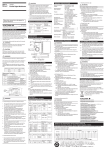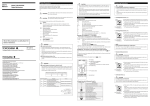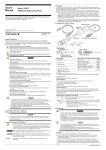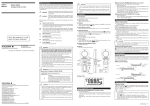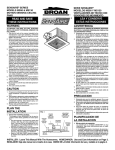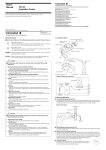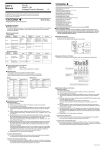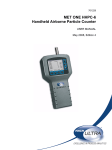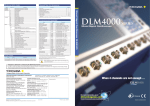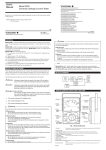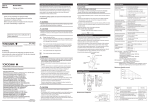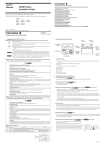Download User`s Manual 73201/02/03/04 Digital Multimeters
Transcript
User's Manual Components Safety Precautions Model 73201/02/03/04 Digital Multimeters When operating the instrument, be sure to observe the cautionary notes given below to ensure correct and safe use of the instrument. If you use the instrument in any way other than as instructed in this manual, the instrument’s protective measures may be impaired. Yokogawa is by no means liable for any damage resulting from use of the instrument in contradiction to these cautionary notes. WARNING CAUTION Indicates a hazard that may result in the loss of life or serious injury of the user unless the described instruction is abided by. Indicates a hazard that may result in an injury to the user and/or physical damage to the product or other equipment unless the described instruction is abided by. The instrument and this manual also use the following safety symbols: Caution This symbol indicates that the operator must refer to an explanation in the instruction manual in order to avoid the risk of injury or death of personnel or damage to the instrument. Double Insulation This symbol indicates double insulation. Alternating current This symbol indicates AC voltage/current. Direct current This symbol indicates DC voltage/current. Fuse This symbol indicates a fuse. Earth TERMINAL This symbol indicates ground. Store this manual in a safe place for future reference. WARNING IM 73201E 7th Edition Dec. 2011(YMI) Disposing the Product This Product complies with the WEEE Directive (2002/96/EC) marking requirement. The affixed product label (see below) indicates that you must not discard this electrical/electronic product in domestic household waste. ■ To avoid electric shock! • Check the testing leads before use and do not use deteriorated or damaged ones. Check the continuity of the testing leads. • Do not use the instrument if there is any damage to the casing or when the casing is removed. • Disconnect the instrument from the circuit under test before opening the casing to replace the batteries or for any other reason. • Avoid using the instrument if it has been exposed to rain or moisture or if your hands are wet. Measuring Instructions 1) Function Switch Turns off the power or selects the measurement mode. OFF: Turns off the power. V: AC voltage measurement V: DC voltage measurement Ω/ : Resistance measurement and continuity check (73202/03) Ω: Resistance measurement (73201/04) : Continuity check (73201/04) : Diode test : Capacitor check (73202/03) µA: DC/AC current measurement in micro-amperes mA: DC/AC current measurement in milli-amperes (73201/02/03) A: DC/AC current measurement in amperes 2) SELECT key (73202/03) or / key (73201)* This function is not supported on the 73204 multimeter. This key is enabled only if the multimeter is in one of the following measurement modes. • Ω/ : In this mode, the key selects between the resistance measurem ent and continuity test. • : In this mode, the key adjusts the stray capacitance of the testing leads and the multimeter itself to zero. (The display shows the CAL symbol.) • µA/mA/A: In this mode, the key selects between the DC and AC modes. * The 73201 multimeter comes with the / key instead of the SELECT key. This key is used only to select between the DC and AC modes in the current measurement mode. 3) RANGE key * This function is not supported on the 73204 multimeter. Allows the operator to select the measuring range manually (the display shows the R • H symbol). To return to the normal auto-ranging mode, hold down this key for at least one second until the display shows “AUTO.” 4) AUTO-H key Set up AUTO HOLD function. (the display shows the A • H symbol). <5> Display <2> SELECT key (73202/03) or ( / = key (73201) <3> RANGE key *(2) and (3) are not supported on the 73204 multimeter. ■ To avoid electrical shock or fire! Do not use the instrument in an atmosphere where any flammable or explosive gas is present. CAUTION To avoid damage to Instrument or equipment. • Before starting measurement, check to which mode the function switch is set and make sure the testing leads are plugged into the terminals for the desired mode of measurement. • Temporarily remove the testing leads from the device under test before operating the function switch. • AC Voltage Measurement ( V / 4/10 Black testing lead Red testing lead • DC Voltage Measurement ( V / 4/10 Black testing lead Red testing lead NOTE If the 400 mV range is selected and the testing leads are left open-circuited, the multimeter may give a certain reading. This does not affect your measurement. • Resistance Measurement (Ω) CAUTION To avoid damage to instrument! Turn off the power to the circuit under test before starting measurement in order to prevent any excessive voltage from being applied to the multimeter. <4> AUTO.H key 4/10 With reference to the equipment types in the WEEE directive Annex 1, this product is classified as a “Monitoring and Control instrumentation” product. WARNING To return unwanted products within the EU area, contact your local Yokogawa Europe B. V. office. Do not dispose in domestic household waste. ■ To avoid damage to instrument or electric shock! Measurement Category Black testing lead Red testing lead Input terminal Maximum Input Voltage CAT. II 600 V CAT. III 300 V Measurement category For measurements performed on circuits not directly connected to MAINS. I CAT. I II CAT. II For measurements performed on circuits Appliances, portable directly connected to the low voltage installation. equipment, etc. III CAT. III For measurements performed in the building installation. Distribution board, circuit breaker, etc. IV CAT. IV For measurements performed at the source of the low-voltage installation. Overhead wire, cable systems, etc. Internal Wiring Entrance Cable CAT. IV Distribution board 5) Display View with All Elements Turned On Symbol and Unit A•H CAT. III CAT. II T CAT. I Fixed Equipment, etc. Outlet Equipment CAUTION IM3E-2011.7 • Continuity Check ( ) To avoid damage to instrument! Remarks Description With caps: 1000V 10A CAT.III / 600V 10A CAT.IV Without caps: 1000V 10A CAT.II / 600V 10A CAT.II a) Place the function switch in the Ω position (73201/04) or Ω/ position (73202/03). b) Plug the black testing lead into the COM input terminal and the red testing lead into the V•Ω• input terminal. c) Connect the testing leads to the circuit under test and then read the multimeter when it stabilizes. d) When measurement is complete, place the function switch in the OFF position and turn off the multimeter. CAUTION Category of Testing leads Yokogawa Meters & Instruments Corporation International Sales Dept. Tachihi Bld. No.2, 6-1-3, Sakaecho, Tachikawa-shi,Tokyo 190-8586 Japan Phone: 81-42-534-1413, Facsimile: 81-42-534-1438 YOKOGAWA CORPORATION OF AMERICA (U.S.A.) Phone: 1-800-888-6400 Facsimile: 1-770-254-0928 YOKOGAWA EUROPE B. V. (THE NETHERLANDS) Euroweg 2, 3825 HD, Amersfoort, THE NETHERLANDS Phone : 31-88-4641000 Facsimile : 31-88-4641111 YOKOGAWA AMERICA DO SUL LTDA. (BRAZIL) Phone: 55-11-5681-2400 Facsimile: 55-11-5681-4434 YOKOGAWA ENGINEERING ASIA PTE. LTD. (SINGAPORE) Phone: 65-6241-9933 Facsimile: 65-6241-2606 YOKOGAWA MEASURING INSTRUMENTS KOREA CORPORATION (KOREA) Phone: 82-2-551-0660 to -0664 Facsimile: 82-2-551-0665 YOKOGAWA AUSTRALIA PTY. LTD. (AUSTRALIA) Phone: 61-2-8870-1100 Facsimile: 61-2-8870-1111 YOKOGAWA INDIA LTD. (INDIA) Phone: 91-80-4158-6000 Facsimile: 91-80-2852-1441 YOKOGAWA SHANGHAI TRADING CO., LTD. (CHINA) Phone: 86-21-6239-6363 Facsimile: 86-21-6880-4987 YOKOGAWA MIDDLE EAST B. S. C (C) (BAHRAIN) Phone: 973-17-358100 Facsimile: 973-17-336100 YOKOGAWA ELECTRIC CIS LTD. (RUSSIAN FEDERATION) Phone: 7-495-737-7868 Facsimile: 7-495-737-7869 <1> Function switch The restrictions on the maximum voltage level for which the 73201, 02, 03 and 04 multimeters can be used, depend on the measurement categories specified by the safety standards. These category specifications are formulated to protect operators against transient impulse voltages in power lines. V) a) Set the function switch from the OFF position to the V position. b) Plug the black testing lead into the COM input terminal and the red testing lead into the V•Ω• input terminal. c) Connect the testing leads to the circuit under test and then read the multimeter when it stabilizes. d) When measurement is complete, set the function switch back to the OFF position and turn off the multimeter. Do not mistake the following for a malfunction! / Product Category V) a) Set the function switch from the OFF position to the V position. b) Plug the black testing lead into the COM input termi nal and the red testing lead into the V•Ω• input terminal. c) Connect the testing leads to the circuit under test and then read the multimeter when it stabilizes. d) When measurement is complete, set the function switch back to the OFF position and turn off the multimeter. • Do not use the multimeter near noise-emitting equipment or where there may be a sudden temperature change. Otherwise, the instrument may produce an unstable reading or errors. • Do not wipe the instrument using any solvent (chemicals) such as benzine or paint thinner. Otherwise, the front panel may be damaged or discolored. When cleaning the instrument, use a dry cloth. • Do not leave the multimeter exposed to direct sunlight or in a hot and humid location such as the inside of a car, for any prolonged length of time. R•H AUTO AUTO POWER OFF nF, µF mV, V µA, mA, A Ω, kΩ, ΜΩ CAL +– Turn off the power to the circuit under test before starting measurement in order to prevent any excessive voltage from being applied to the multimeter. Description Lit when in DC-mode measurement Lit when in AC-mode measurement Polarity indicator lit when the polarity is negative Lit when in diode test Lit when in continuity check AUTO HOLD indicator Manual range indicator Auto range indicator AUTO POWER OFF indicator Unit for capacitance measurement Unit for voltage measurement Unit for current measurement Unit for resistance measurement Lit when stray capacitance is adjusted to zero Lit when the batteries are low / 4/10 Black testing lead Red testing lead a) If the model is 73201 or 04, place the function switch in the position. If the model is 73202 or 03, place the function switch in the Ω / position, and then press the SELECT key. (The symbol appears on the display.) b) Plug the black testing lead into the COM input terminal input terminal. and the red testing lead into the V•Ω• c) Connect the testing leads to the circuit under check. If the circuit is continuous (no more than approximately 50 Ω), the buzzer sounds. d) When the test is complete, place the function switch in the OFF position and turn off the multimeter. • Diode Test ( ) a) Set the function switch from the OFF position to the position. b) Plug the black testing lead into the COM input terminal and the red testing lead into the V•Ω• input terminal. c) Connect the testing leads to the diode and then read the multimeter when it stabilizes. / 4/10 (1) Forward-bias Diode Test Connect the black testing lead to the cathode and the red testing lead to the anode (see Figure 1). Silicon diodes should give a reading of approxiBlack testing Red testing mately 0.5 V and light-emitting diodes a reading lead lead between 1.5 V and 2.0 V. Note that readings close to 0 V represent a short-circuit and the "---" symbol indicates an opencircuit. (2) Reverse-bias Diode Test Connect the black testing lead to the anode and the red testing lead to the cathode (see Figure 2). Figure 1 Forward-bias Normally, the display shows the "---" symbol, Diode Test indicating that the diode under test is normal. Red testing Black testing The diode is defective if the display gives a lead lead certain voltage level. Black testing lead Red testing lead d) When the test is complete, set the function switch back to the OFF position and turn off the multimeter. Figure 2 Reverse-bias Diode Test • Capacitor Check ( ) *This function is not supported on the 73201/04 multimeters. CAUTION To avoid damage to Instrument or equipment. Before starting measurement, be sure to discharge the capacitor under check. / 4/10 Red testing lead Black testing lead NOTE a) Set the function switch from the OFF position to the position. b) Plug the black testing lead into the COM input terminal and the red testing lead into the μA • mA • input terminal. c) Press the SELECT key to adjust the stray capacitance CAL symbol). to zero (thedisplay shows the CAL d) Connect the testing leads to the circuit under check and then read the multimeter when it stabilizes. e) When measurement is complete, set the function switch back to the OFF position and turn off the multimeter. AUTO HOLD Function The 732 series of multimeters can automatically retain the measured value when the testing leads are handled as described below. a) Press the AUTO.H key. (The display shows the A • H symbol.) b) Connect the testing leads to the object under test. c) When the reading stabilizes, the buzzer sounds. d) Remove the testing leads from the object under test. e) The multimeter now shows the measured value that it retains. f) You can repeat steps b) to e) as many times as you like as long as the display shows the A • H symbol. NOTE Do not mistake the following for a malfunction! • In DC voltage measurement, the AUTO HOLD function is only available for ranges greater than the 4 V range. • This function is not available for current-mode measurement. • In a capacitor check, the AUTO HOLD function requires a few seconds before it takes effect. • The AUTO HOLD function cannot be applied to unstable signals. g) To cancel this function, press the CAUTION To avoid damage to instrument! • Check to which mode the function dial is set before starting measurement. • A current of 11 to 20 A can also be measured if the time interval is kept within 30 seconds. The buzzer will sound if the interval exceeds 30 seconds. If this happens, immediately stop measurement. To continue measurement, wait for 2 minutes or more when restart. a) Set the function switch from the OFF position to either the μA, mA or A position. (If the magnitude of the current being measured is not known, select the A position.) b) When measuring AC current, press the SELECT key to select the AC mode. (The display shows the “ ” symbol to indicate AC-mode measurement.) c) Plug the black testing lead into the COM input terminal and the red testing lead into the A input terminal. If the current is in the order of milli-amperes or less, plug the red testing lead into the μA•mA• input terminal. d) Connect the testing leads to the circuit under test and then read the multimeter when it stabilizes. e) When measurement is complete, set the function switch back to the OFF position and turn off the multimeter. mA mA / 4/10 Red testing lead Black testing lead A A / 4/10 Red testing lead Black testing lead key once again. The multimeter automatically turns off if no key is pressed for a period of 20 minutes. The multimeter will beep for approximately one minute to alert the operator before the automatic power-off function takes effect. (Pressing any key while the multimeter is beeping postpones the power-off time. Pressing any key once after the power to the multimeter is automatically turned off switches the multimeter on again.) To cancel the automatic power-off function, hold down the SELECT key and then set the function switch from the OFF to the position of any desired measurement mode. (The AUTO POWER OFF indication turns off when the function is canceled.) To enable the function once again, temporarily switch the function switch back to the OFF position, and then select the desired measurement mode. Battery Replacement If the batteries fall below the normal operating voltage, the symbol turns on. If this happens, replace the batteries with new ones (AAA-size [ANSI] batteries: 2pcs.). CAUTION To avoid electric shock! • Be sure to disconnect the multimeter from the circuit under test before replacing the batteries. • Replace both batteries at the same time making sure to position them with the correct polarities. Zero calibration is only effective when the 20nF range is selected. • Current Measurement (μA/mA/A) *This fucntion is not supported on the 73204 multimeter. A•H AUTO POWER OFF Function Do not mistake the following for a malfunction! • AC Current Measurement ( A) * This function is not supported on the 73204 multimeter. Specifications To replace the batteries: Remove the three screws on the back of the casing. Open the casing. Take the battery holder out of the casing. Replace the batteries with new ones and install the battery holder back into the casing. e) Close the casing and fasten it with the three screws. b) a) b) c) d) c) 1. General Specifications Fuse Replacement If a current greater than the rated value flows when the multimeter is in the current-measurement range, a protection fuse may blow. If this happens, replace that fuse. The multimeter contains the following two types of fuses: • Type F05 250 V/500 mA fuse • Type F02 250 V/15 A fuse CAUTION To avoid electric shock! • Be sure to disconnect the multimeter from the circuit under test before replacing the fuse(s). • Do not operate the multimeter with the casing left open. • In order to avoid damage to the multimeter or any possible accident, use fuses of the specified rating. To replace the fuse(s): a) Remove the three screws on the back of the casing. b) Open the casing. c) Remove the blown fuse from the fuse holder. d) Install a new fuse in the holder. F02:15 A/250 V protection fuse e) Close the casing and fasten it with the F05:500 mA/250 V three screws. protection fuse View with the Casing Open 4000 μA Accuracy (40-500 Hz) Resolution 73201 73202 73203 0.1 μA 2% + 20 1 μA 2% + 5 mA 40 mA*2 0.01 mA A 400 mA 10 A*3 0.1 mA 0.01 A Range 400 μA*1 µA Voltage Drop Maximum Input Current 400 mA The input is protected by a 500mA/250 V fuse <0.17 mV/μA 2% + 20 2% + 5 2.5% + 20 <3 mV/mA 10 A The input is protected by a 15 A/250 V fuse <0.04 V/A *1, *2 These ranges may produce a readout error equivalent to several times their resolution. *3 A current of 11 to 20 A can also be measured if the time interval is kept within 30 seconds. The buzzer will sound if the interval exceeds 30 seconds. Response: 2 sec maximum • Resistance Measurement (Ω) Resolution Range 400 Ω 0.1 Ω 4 kΩ 0.001 kΩ Accuracy 73201/02/03/04 0.75%+2 0.75%+1 Measuring Current Open-loop Voltage Input Protective Voltage <1.0 mA <3.4 V 600 V <0.5 mA <1.0 V <0.7 V 40 kΩ 0.01 kΩ <70 μA 400 kΩ 0.1 kΩ <7 μA 4 MΩ 0.001 MΩ 2%+1 40 MΩ 0.01 MΩ 5%+2 Response: <0.7 μA <70 nA 1 sec maximum for ranges lower than the 400 kΩ range, 5 sec maximum for the 4 MΩ range, and 15 sec maximum for the 40 MΩ range • Continuity check ( Range ) Range of operation Resolution Open-circuit Voltage 73201/02/03/04 400 Ω 0.1 Ω The buzzer turns on for resistances lower than 50 ±20 Ω. Input Protective Voltage <3.4 V 600 V Open-circuit Voltage Input Protective Voltage <3.4 V 600 V Response: 0.2 sec maximum (for a buzzer response) • Diode Test ( Range 2V ) Resolution Accuracy 0.01 V 73201/02/03/04 1% + 1 (for measuring currents smaller than 1.0 mA) Response: 1 sec maximum • Capacitor check ( Range Resolution ) 20 nF 0.01 nF 200 nF 0.1 nF 2 μF 0.001 μF 20 μF 0.01 μF 200 μF 0.1 μF Protection Fuse Accuracy 73201/04 73202 73203 This function 2% + 5 typical is not Readings in the 20nF available. range are values after zero calibration has been completed. By means of a 500 mA/250 V fuse 2. Accuracy (Electrical Specification) Test conditions: 23 ±5°C at 80% RH maximum Accuracy: ±(percentage of reading + number of LSD reading) Note: Each response noted below is a value measured in the Range Hold mode (manual range setting). Response: 1 sec maximum • DC Voltage Measurement ( This User’s Manual explains the Prevention of Pollution Control of Electronic Equipment Method in China. This manual is valid only in China. Range a) (Mean-value detection and rms-value calibration) • Measurement functions: AC voltage, DC voltage, AC current (73201/02/03), DC current (73201/02/03), resistance, continuity, diode and capacitance (73202/03) Auto hold, manual range selection, over-range • Additional functions: alarm, and Auto power off. • Display: LCD display that is capable of indicating a significant reading of up to 4300 counts along with the indications of the unit and function. It shows the negative polarity only; no indication is given for positive polarity. The display also has the OL or over-range and lowbattery alarm indicators. Note: The most significant reading is 210 counts for the diode test and 2300 counts for the capacitor check. • Range selection: Manual or automatic • Sampling: 2 times/sec • Operating temperature and humidity ranges: 0 to 50°C (Accuracy guaranteed range: 23±5°C) Where the range is 0 to 40°C for humidity of 80%RH or less and 40 to 50°C for humidity of 70%RH or less • Storage temperature and humidity ranges: -20°C to 60°C; 70% RH maximum • Battery life: Approximately 600 hours (when continuously operated on alkaline batteries) AAA-size batteries (ANSI) .........................2pcs. • Power supply: • External dimensions: Approx.74 (W) × 155 (H) × 31 (D) mm (excluding protrusions) • Weight: Approx. 240 g (including batteries) EN 61010-1, EN 61010-031 • Safety standards: (AC/DC 300V CAT.III, AC/DC 600 V CAT. II, Pollution degree2) Operable altitude : 2000m max above sea level, Indoor use • EMC standards: EN 55011 Group 1 Class B EN 61326-1, EN 61326-2-2 • Effect of EMS immunity: Accuracy range of reading: (Rated accuracy of each range) ×5 for the strength of a radiofrequency electromagnetic field of 3 V/m • Accessories: Batteries (housed in the instrument) ..........2pcs. Testing leads..............................................1set Spare fuse: F05 (500 mA/250 V) ................1 F02 (15 A/250 V) .....................1 User’s manual ..........................................1 V) Accuracy 73202/04 Resolution Input Resistance Maximum Input Voltage 73201 73203 400 mV 0.1 mV 0.5%+1 >100MΩ 600 V 4V 0.001 V 11MΩ 0.5%+1 0.3%+ 1 40 V 0.01 V 10M Ω 0.1 V 400 V 0.75%+1 1V 600 V Response: 1.5 sec maximum for 400 mV range or 1 sec maximum for other ranges • AC Voltage Measurement ( Range Resolution 4V 0.001 V 40 V 0.01 V 400 V 0.1 V 600 V 1V Response: 2 sec maximum V ) (Mean-value detection and rms-value calibration) Accuracy (40-500 Hz) 73201 73202 73203/04 1%+5 0.75%+5 Input Resistance Maximum Input Voltage 11 MΩ, <50 pF 10 MΩ, <50 pF 600 V μA mA A 400 μA*1 4000 μA 40 mA*2 400 mA 10 A*3 Resolution 0.1 μA 1 μA 0.01 mA 0.1 mA 0.01 A 产品中有毒有害物质或元素的名称及含量 有毒有害物质 部件名称 铅 (Pb) 汞 (Hg) 镉 (Cd) 六价铬 (Cr (VI)) 多溴联苯 (PBB) 多溴二苯醚 (PBDE) 框架(塑料) × × × × ○ ○ 线路板 ASSY × × × × ○ ○ 导线 × × × × ○ ○ 电池 × × × × ○ ○ ○:表示该部件的所有均质材料中的有毒有害物质的含量均在 SJ/T11363-2006 标准中所规定的限量 以下 ×:表示该部件中至少有一种均质材料中的有毒有害物质或元素的含量超过 SJ/T11363-2006 标准所规 定的限量要求。 环保使用期限 : • DC Current Measurement ( A) * This function is not supported on the 73204 multimeter. Range "Measures for Administration of the Pollution Control of Electronic Information Products" of the People's Republic of China 73201 Accuracy 73202 73203 1% + 2 2% + 2 Voltage Drop Maximum Input Current <0.17 mV/μA 400 mA The input is protected by a 500 mA /250 V fuse <3 mV/mA <0.04 V/A 10 A The input is protected by a 15 A /250 V fuse *1, *2 These ranges may produce a readout error equivalent to several times their resolution. *3 A current of 11 to 20 A can also be measured if the time interval is kept within 30 seconds. The buzzer will sound if the interval exceeds 30 seconds. Response: 1 sec maximum 该标识适用于 2006 年 2 月 28 日颁布的《电子信息产品污染控制管理办法》 以及SJ /T11364 – 2006《电子信息产品污染控制标识要求》中所述, 在中华人民 共和国销售的电子信息产品的环保使用期限。 只要您遵守该产品相关的安全及使用注意事项,在自制造日起算的年限内,则不 会因产品中有害物质泄漏或突发变异, 而造成对环境的污染或对人体及财产产生 恶劣影响。 注)该年数为“环保使用期限" ,并非产品的质量保证期。零件更换的推荐周期, 请参照使用说明书。 IM 73201E <P2>


